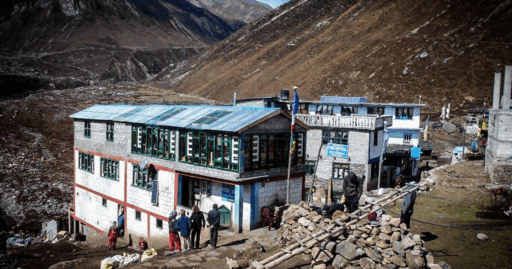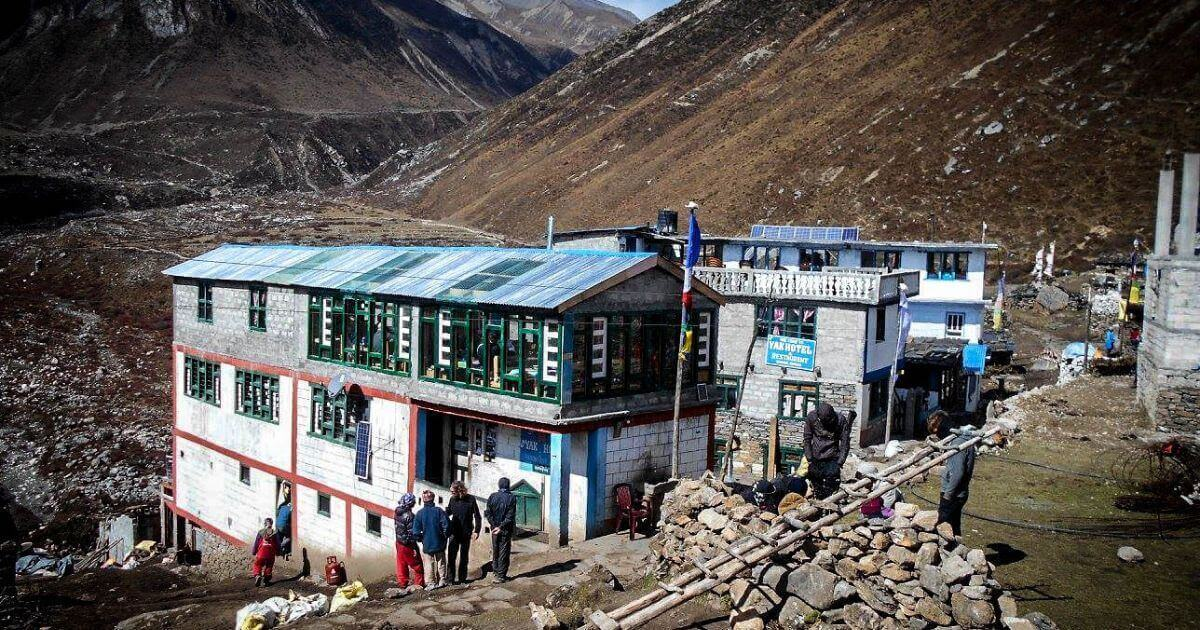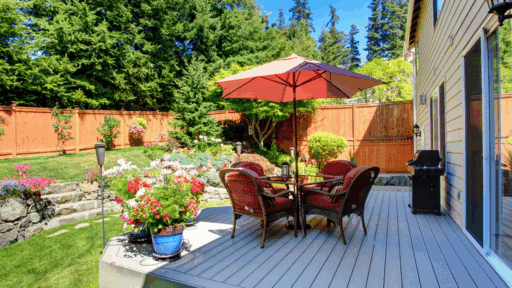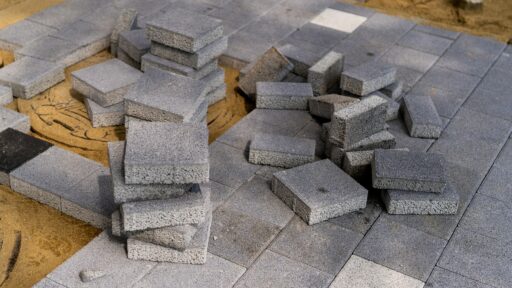When you think of the Manaslu Circuit, you probably picture snow-capped mountains, remote trails and the mighty Manaslu peak at 8,163 meters. But this trek is about so much more than natural beauty. One of the most overlooked but fascinating aspects of the Manaslu region is its architecture — the types of houses and settlements you see along the trail.
Each house tells a story. From the lower tropical foothills to the high-altitude Tibetan-style villages, the houses reflect the climate, resources, traditions and the spirit of the local people. In this in-depth guide you’ll discover the main types of houses on the Manaslu Circuit, what makes them unique and how they impact your trek.
Why Mountain Houses Matte
Many people come to the Manaslu circuit trek for its snow peaks, glacial valleys and sense of adventure on lesser-trodden trails. But to really connect with what makes Manaslu special you have to look beyond the scenery and pay attention to the everyday details of village life along the trail. Every cluster of stone houses on a steep hillside, every fluttering string of prayer flags on a roof beam and every dry-stone wall around a herd of yaks tells a story of resilience, faith and a deep connection with the land.
The architecture here isn’t just functional — it’s a record of how communities have survived harsh winters, heavy monsoons and isolation for centuries. These villages with their unique houses, courtyards, fields and monasteries are living museums of Himalayan culture.
As you walk through them you’re not just trekking through a wilderness of mountains; you’re witnessing a living culture that has learned to thrive in some of the world’s most challenging terrain. This is what turns your journey into more than just a trek — it becomes an intimate glimpse into the spirit of the people who call these wild valleys home.
The Ethnic Mosaic of the Manaslu Region
Before you can appreciate the amazing architecture along the Manaslu Circuit, you need to understand who the people are behind these houses. The Manaslu region is a cultural crossroads where different ethnic groups have settled over centuries, each leaving their mark on the landscape. In the lower, warmer hills you’ll mostly see Gurungs and Magars — farming communities with strong social ties. As you go higher into valleys like Nubri and Tsum, the villages are inhabited by people of Tibetan origin like the Tsumbas and those near Larkya La Pass. These groups practice Tibetan Buddhism and have a deep spiritual connection with the mountains. Their religious beliefs, ancestral customs, and the harsh environment have shaped how they build their homes — from the materials they use to the protective symbols painted on the walls.
Understanding this ethnic mosaic not only helps you see the houses as more than just stone and wood but also how architecture becomes an expression of identity, spirituality, and survival in these remote Himalayan valleys. And while you soak in this unique culture, it’s worth knowing that a typical Manaslu Circuit Trek cost ranges from $1,000 to $1,800 USD, depending on your group size, guide and porter services, permits, and accommodation style — a fair price for an unforgettable experience that connects you with both nature and the people who call this region home.
Traditional Stone Houses of the Lower Hills
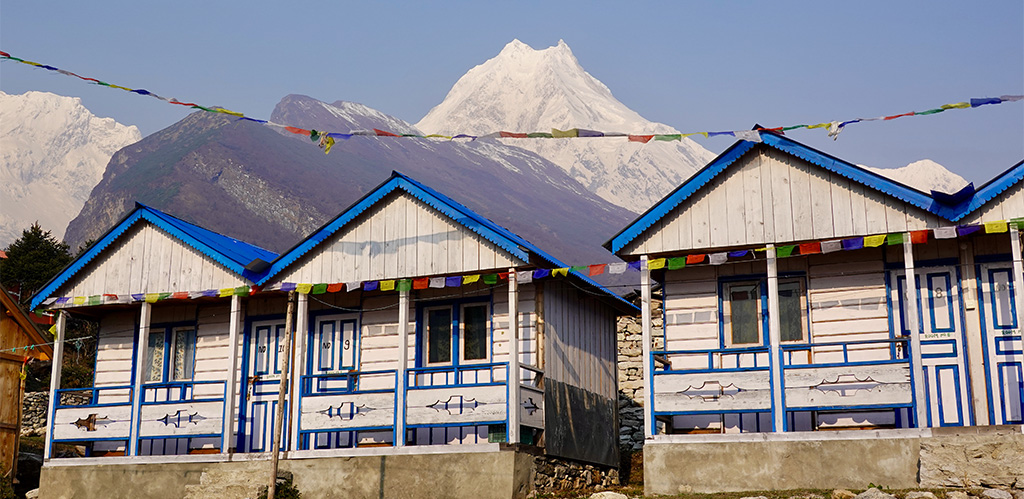
When you start your Manaslu trek from villages like Arughat or Machha Khola you’ll pass through small settlements where most houses are made of stone. People use stone because it’s easily available and keeps the inside of the house warm in cold weather.
The roofs are built at an angle so that rain and snow slide off easily and don’t collect on top. The windows are small to stop warm air from escaping and to keep out cold winds. The doors and windows have strong wooden frames made from local trees.
Around these houses you’ll see beautiful terraced fields, vegetable gardens and sheds for animals like goats and buffalo. These simple but practical homes surrounded by farmland give the villages a cozy and welcoming feel as you walk through the lower hills.
Wooden Houses and Mixed-Style Buildings
As you trek through the mid-altitude villages like Philim and Namrung you’ll notice the houses start to look different. Instead of being made completely of stone these houses often have strong stone bases on the ground floor to keep the house sturdy and warm.
On the upper floors you’ll see more wood — especially balconies and open areas where people hang corn, herbs and chilies to dry in the sun.
Many of these houses now have tin roofs instead of the old wooden shingles because tin does a better job of keeping out heavy rain. This mix of old and new materials shows how villagers keep their traditional building style but also make small changes to suit modern needs and weather conditions.
Tibetan-Style Flat Roof Houses in Upper Manaslu
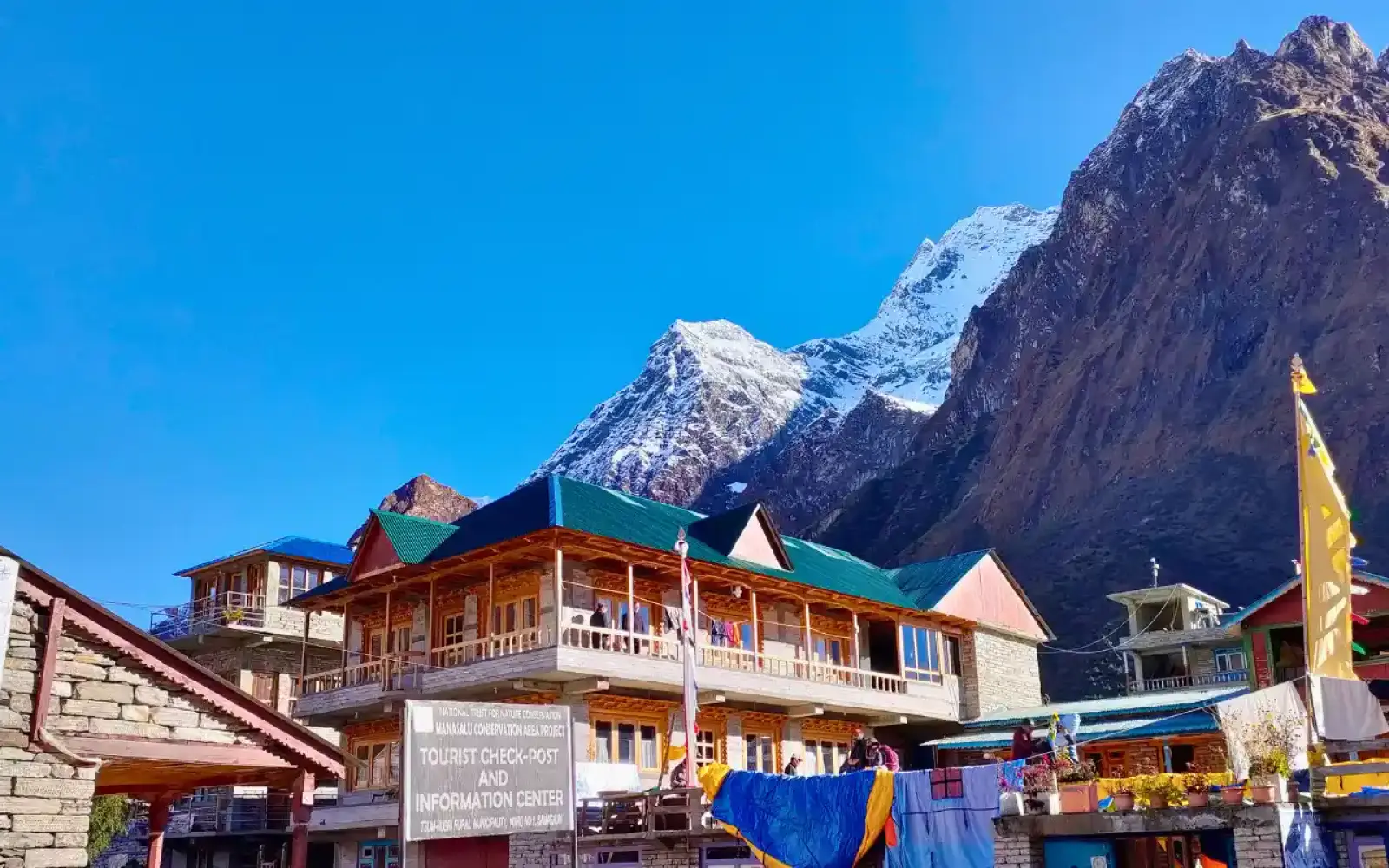
One of the most striking things you’ll see as you reach the higher villages on the Manaslu Circuit — places like Lho, Shyala, Samagaun and Samdo — is the Tibetan-style houses with flat roofs.
Unlike the sloping roofs in the lower areas these roofs are flat so people can use them for practical things like drying grains, storing firewood or hanging prayer flags. These houses often have thick whitewashed walls and brightly painted windows which stand out beautifully against the rocky, snowy landscape. This style comes from Tibetan culture and fits the dry, cold climate of the high mountains. Seeing these flat-roofed houses surrounded by mountains and prayer flags really gives you the feeling of being close to Tibet and its unique traditions.
Key Features:
- Flat Roofs: Used for drying grains, storing firewood and sometimes hosting prayer flags or small chortens.
- Whitewashed Walls: Often painted with symbols like the Eight Auspicious Signs.
- Colorful Windows: Brightly painted window frames stand out against the stark mountain landscape.
- Mani Walls and Prayer Wheels: Many houses are built around these religious elements, blending daily life with Buddhist practice.
These houses are practical — the flat roofs make sense in the dry, cold climate and help families store supplies for the long winter months.
Teahouses: The Evolution of Trekker Lodges
When you trek the Manaslu Circuit you’ll probably spend most nights in teahouses — which are a big part of the trekking experience in Nepal. But what are teahouses exactly? Long ago these were just regular family homes where villagers gave passing traders or pilgrims a warm meal and a place to sleep.
As more trekkers started visiting the region these homes grew into small guesthouses. Today some teahouses are very basic with thin walls, simple beds and shared toilets.
Others are a bit more modern with private rooms, hot showers and sometimes even WiFi if you’re lucky! Staying in these local teahouses is a great way to rest, enjoy home-cooked meals and get a closer look at village life along the trail.
How Teahouses Are Built:
- Mostly stone or brick with tin or corrugated iron roofs.
- Communal dining rooms with a stove at the center.
- Bedrooms with thin plywood walls and simple beds.Staying in locally owned teahouses supports the villagers directly and gives you a glimpse into local daily life.
Yak Huts and Temporary Shelters
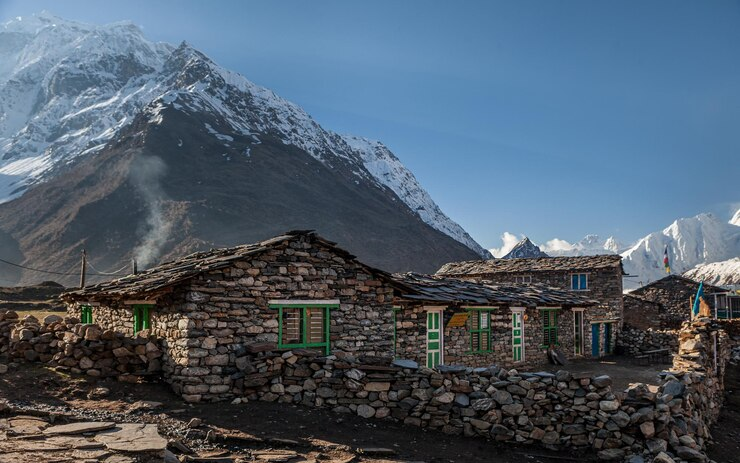
Higher up on the Manaslu Circuit, especially near Samdo and Dharmasala (also called Larke Phedi), you’ll see small yak huts or temporary stone shelters. Local herders use these simple shelters during the summer when they take their yaks and other animals up to the high pastures to graze.
These huts are made from loose stones stacked together without any cement. They’re very basic — just enough to provide some protection from the cold and wind. Inside, you’ll find a simple fire for cooking and maybe some blankets for sleeping.
These huts show how people here still live in tune with the seasons and move with their animals to find fresh grass high in the mountains.
- Built from Loose Stones: Dry-stone walls without mortar.
- Minimal Roofs: Sometimes just a tarp or rough wooden beams covered with rock slabs.
- Basic Interiors: Hearth for cooking and blankets for sleeping.
These huts are a glimpse into the semi-nomadic lifestyle of yak herders who move with the seasons to find grazing pastures.
Monasteries and Gompas: More than Just Religious Hubs
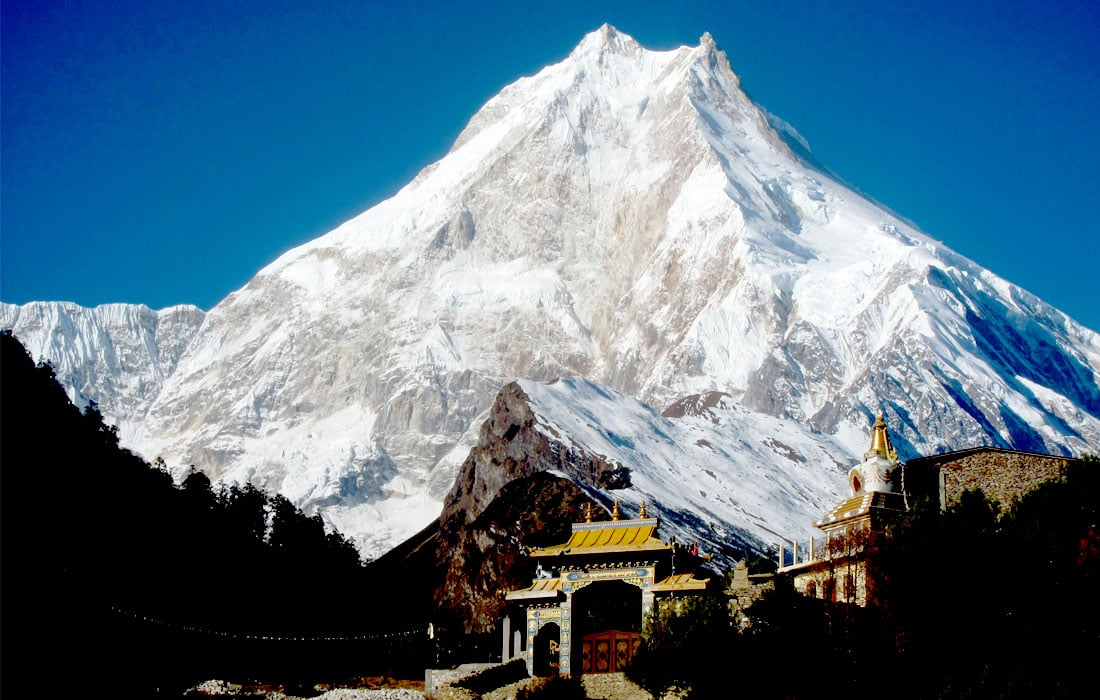
As you walk the Manaslu Circuit you’ll also see old monasteries that add to the region’s spiritual atmosphere.
For example, you might visit Ribung Gompa in Lho or the ancient Pung Gyen Gompa above Samagaun with stunning views. These monasteries are built in the Tibetan style, with large prayer halls where monks gather to chant and hold ceremonies.
Many have intricate woodwork, murals and prayer wheels that you can spin for good luck. Often small houses and villages are built nearby, showing how important these monasteries are to daily life. They’re not just places of worship — they’re community centers where religion, culture and village life come together high in the Himalayas.
- Large prayer halls.
- Residences for monks.
- Wooden carvings and murals.
Many houses are clustered near these religious centers, highlighting the connection between architecture and spirituality.
Materials Used
The houses and buildings along the Manaslu Circuit are made almost entirely from local materials.
Stones are used for walls and fences. Wood from the nearby forests is shaped into beams, window frames, doors and roof supports. Mud and clay acts as glue to hold the stones together. For the roofs, people use slate if available, or tin sheets which are easier to install and last longer in bad weather.
Because it’s so difficult and expensive to carry heavy building materials up these remote mountain trails, villagers rely on what they can gather nearby. This makes the architecture practical, affordable and sustainable and helps people live in harmony with their rugged environment.
How Climate Affects Local Houses
The houses along the Manaslu Circuit have to withstand some tough weather conditions. In the lower areas, there are heavy monsoon rains so the roofs have to shed lots of water. Higher up, villages get snow in winter which can pile up on the roofs and walls. In the wide open valleys, strong winds blow through making it even colder.
Because of all this, local houses are built with thick stone walls to keep the cold out and the warmth in. They have small windows to stop heat from escaping and low, sturdy roofs that can handle rain, snow and strong winds. All these smart design choices help families stay safe and warm in the mountains.
Living with the Locals: What Trekkers Should Know
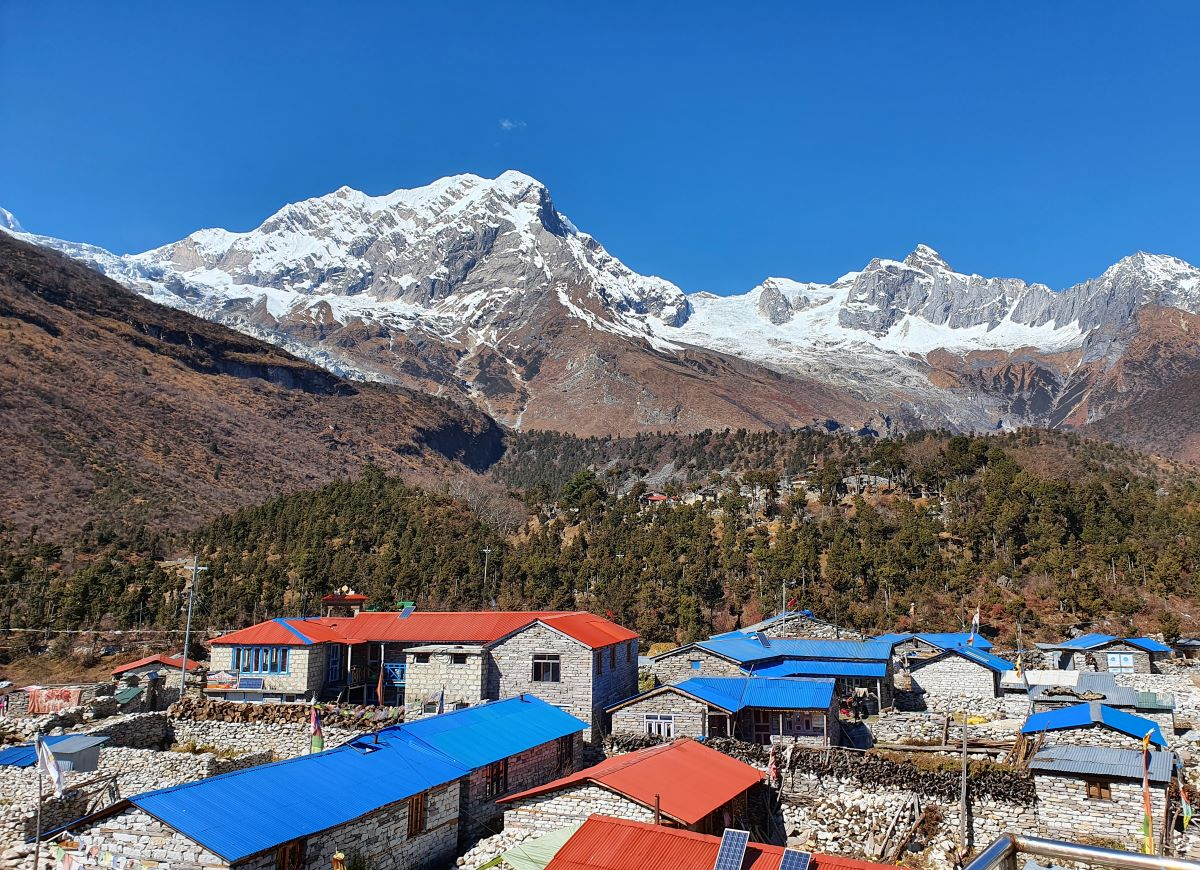
When you stay in a teahouse during your Manaslu trek, remember it’s not like staying in a hotel — you’re a guest in someone’s family home. So respect local customs while you’re there.
Take off your shoes before going into rooms to keep the inside clean. Dress modestly especially in shared spaces like the dining hall.
Don’t waste food or water as everything is brought up the mountain by porters or animals. And don’t be surprised if your bedroom is cold — they’re not heated! Instead spend your evenings in the dining hall around the warm stove where you can relax and get to know other trekkers and your hosts.
Final Thoughts: Beyond the Trail
The Manaslu Circuit Trek is not just a physical challenge; it’s a cultural experience. The different types of houses you see — from stone cottages to Tibetan lodges — are a story of centuries of adaptation, faith and community.
Next time you stop for tea in a village, look at the walls, the roof, the prayer flags flapping in the wind. They are more than shelter — they’re living history.

